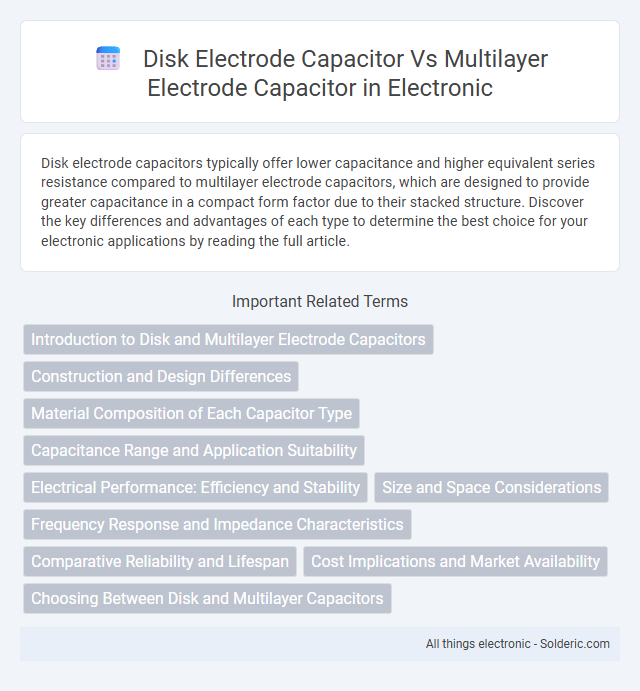Disk electrode capacitors typically offer lower capacitance and higher equivalent series resistance compared to multilayer electrode capacitors, which are designed to provide greater capacitance in a compact form factor due to their stacked structure. Discover the key differences and advantages of each type to determine the best choice for your electronic applications by reading the full article.
Comparison Table
| Feature | Disk Electrode Capacitor | Multilayer Electrode Capacitor |
|---|---|---|
| Electrode Structure | Single disk-shaped electrode | Multiple stacked electrode layers |
| Capacitance Density | Lower capacitance per volume | Higher capacitance per volume |
| Size | Larger and bulkier | Compact and smaller footprint |
| Equivalent Series Resistance (ESR) | Higher ESR | Lower ESR due to shorter current path |
| Operating Frequency | Better at low frequencies | Suitable for higher frequency applications |
| Thermal Performance | Moderate heat dissipation | Improved thermal performance |
| Manufacturing Complexity | Simple and cost-effective | More complex manufacturing process |
| Application | Power supplies, audio circuits | High-frequency circuits, filters |
Introduction to Disk and Multilayer Electrode Capacitors
Disk electrode capacitors use a single, flat electrode disk, offering high capacitance and low equivalent series resistance (ESR) in compact sizes. Multilayer electrode capacitors consist of stacked layers of electrodes and dielectric materials, enabling higher capacitance values and improved voltage ratings within a smaller volume. Your choice depends on space constraints and performance requirements, with disk types excelling in stability and multilayer types in capacitance density.
Construction and Design Differences
Disk electrode capacitors utilize a single layered electrode design with a circular plate structure, enabling high capacitance in a compact footprint, while multilayer electrode capacitors consist of multiple stacked electrode layers separated by dielectric material, significantly increasing surface area and capacitance density. The construction of disk capacitors typically involves fewer layers, making them simpler but less efficient in space utilization compared to multilayer capacitors that achieve higher capacitance through intricate layering and internal electrode interleaving. Multilayer electrode capacitors often incorporate ceramic or polymer dielectrics with precise layer thickness control, resulting in improved performance and reliability over the single-layer disk electrodes.
Material Composition of Each Capacitor Type
Disk electrode capacitors typically utilize aluminum or tantalum as their primary electrode materials, combined with a dielectric layer of metal oxide formed through anodization. Multilayer electrode capacitors, often ceramic capacitors, consist of alternating layers of metal electrodes such as silver, palladium, or nickel, embedded within ceramic dielectric layers like barium titanate or other perovskite-type materials. The material composition impacts the capacitors' electrical properties, including voltage rating, capacitance stability, and frequency response.
Capacitance Range and Application Suitability
Disk electrode capacitors typically offer capacitance values ranging from a few microfarads to several hundred microfarads, making them suitable for power supply filtering and audio applications. Multilayer electrode capacitors provide a broader capacitance range, often from picofarads to several microfarads, excel in high-frequency circuits, and are ideal for surface-mount technology in compact electronic devices. The choice between these capacitors depends on the required capacitance range and specific application needs such as size, frequency response, and mounting type.
Electrical Performance: Efficiency and Stability
Disk electrode capacitors exhibit higher efficiency due to lower equivalent series resistance (ESR) and superior frequency response, making them ideal for high-current applications. Multilayer electrode capacitors offer enhanced stability and capacitance per volume through stacked electrode structures, ensuring consistent performance over long operational cycles. Both capacitor types maintain robust dielectric properties, but disk electrodes prioritize transient efficiency while multilayer designs optimize long-term stability.
Size and Space Considerations
Disk electrode capacitors typically occupy more space due to their larger, cylindrical shape, making them less suitable for compact circuit boards. Multilayer electrode capacitors are designed with stacked layers, significantly reducing size and allowing for higher capacitance in a smaller footprint. If your project requires saving space without compromising performance, multilayer capacitors offer a more efficient solution.
Frequency Response and Impedance Characteristics
Disk electrode capacitors typically offer lower inductance and better high-frequency response due to their symmetric structure, making them suitable for applications requiring minimal impedance at elevated frequencies. Multilayer electrode capacitors feature multiple stacked layers, which increase capacitance but can introduce higher parasitic inductance and resistance, resulting in diminished frequency response and increased impedance at higher frequencies. Understanding your application's frequency demands is essential to choosing between the low impedance performance of disk electrode capacitors and the higher capacitance yet elevated impedance traits of multilayer designs.
Comparative Reliability and Lifespan
Disk electrode capacitors generally offer higher reliability and longer lifespan due to their robust construction and lower equivalent series resistance (ESR), making them suitable for high-stress applications. Multilayer electrode capacitors, while compact and efficient for high capacitance in small volumes, may have shorter operational life and greater susceptibility to environmental stress like temperature and voltage fluctuations. Your choice depends on application demands, with disk capacitors favored for durability and multilayer variants for size efficiency.
Cost Implications and Market Availability
Disk electrode capacitors generally have higher manufacturing costs due to their complex assembly and materials, making them less cost-effective for high-volume applications. Multilayer electrode capacitors benefit from automated production processes, resulting in lower costs and greater affordability for mass-market electronic devices. Market availability is broader for multilayer capacitors, which dominate consumer electronics, while disk capacitors are more specialized and less prevalent in general markets.
Choosing Between Disk and Multilayer Capacitors
When choosing between disk and multilayer electrode capacitors, consider your circuit's size, voltage requirements, and capacitance needs. Disk capacitors typically offer higher voltage ratings and stable performance in high-frequency applications, while multilayer capacitors provide compact size and higher capacitance per volume. Your decision should be based on balancing space constraints with electrical specifications to ensure optimal functionality.
disk electrode capacitor vs multilayer electrode capacitor Infographic

 solderic.com
solderic.com